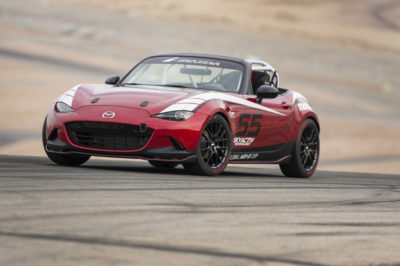The first development vehicle for the 2016 MX-5 Cup car has hit the track for some systems checks.
On Tuesday, April 7, the fourth generation (ND) Mazda MX-5 race car put tire to racetrack for the first time, in its first shakedown.
For those who understand the adage, Long Live the Roadster, you likely know that the road car will be available this summer; the race car is close behind with target availability in October.
Long Road Racing (LRR), Mazda Motorsports’ partner assisting in the development of the 2016 MX-5 road car into the next generation Global Cup car, received the first three road cars for development last month. LRR gave each prototype a specific purpose in the development process, and took one of them to VIRginia International Raceway for its first private test.
Piloted by Mazda factory driver and professional driving coach Tom Long, the test had several chief objectives: ensure that all systems operated as designed; collect comparison data for the seven-post rig (more on the multi-post rig next week); and identify the initial performance parameters.
Ensuring the systems operated as designed: “Systems integration” is key and checking how well all of the various systems (e.g., engine, cooling, transmission) work together. As an example, the transmission gear ratios are critical for drivability on the race track. According to Long, “The gear spacing is extremely well suited for the racing environment. The gearbox is very smooth, predictable, and has a nice throw length; it even feels to be an upgrade from the current NC model [the third generation MX-5 Cup car].”
To identify the initial performance parameters, the team tested and monitored the systems check, electrical components, drivetrain and chassis.
The systems checks: Our focus for this short test was on the cooling and brakes. The goal is to run between 170° and 190°; it ran at 185°and idled at 200°. Our first design of a racing radiator certainly looks good so far. Further testing will take place in drafting and high ambient temperatures to confirm that we keep temperatures under control in all environments and racing situations. Though the car was run at 80 percent of its capability for the purpose of this test, the ABS was still checked and gave really good feedback. The brakes will be pushed more to their limits during the coming sessions as we have several different manufacturers’ brakes to test.
Electrical: The factory traction and stability controls (TS/SC), along with an AiM data acquisition system were also tested. While well suited for the street, the TC/SCs were best left off on the race track. The AiM dash picked up all the basic vitals (e.g., water temp, speed, lap time, rpm). There were also shock potentiometers, velocity meters, tire temperature monitoring that collected live track data for use in synchronizing multi-post data and track actuals.
The drivetrain: The engine, differential, and transmission were all points of interest. Tom reported, “The engine revved freely and shifted mostly in the 6500rpm range, which was appropriate for the initial testing run. The light flywheel really helps with the quick blipping of downshifts.” The gearbox, as we previously noted, felt great.
The suspension: The springs, dampers, and sway bars were noted, but, again, not the focus. Lots more on this in the future.
So how do we feel? Simply, really excited. The test went extremely well and there is much to look forward to.
What’s next? We asked Tom what his thoughts are for the next test. Of course, as a racer, he was excited to report that the next phase will be to push the performance limits of the car. And we share in his sentiments of wanting to go fast into, through, and out of the corners (not just a drag race and park it kind of car that does not build on your craft as much). He replied, “I’m really excited that we are now at the point of tuning the suspension, in particular. The suspension tuning will be critical to make the ND Cup car drive ‘like it matters.’ Of course, our goal is to continue building on it. Though it won’t be easy to improve the handling since Mazda has always done such a great job with it, we do have an advantage with this car since it is approximately 200lbs. lighter and we have been learning about developing these road cars into race cars since the first gen.”
If your career matters, sign up to receive email updates on the development of the global MX-5 Cup car. If you want to place an order for the first 1,000 road cars or receive email updates, click here.
Related Content:
The Build Begins
MX-5 Cup Goes Global


 ACCESSIBILITY
ACCESSIBILITY